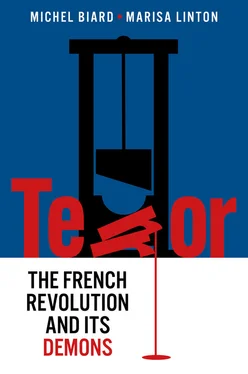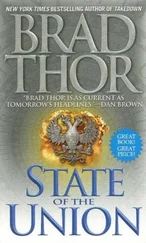With Robespierre eliminated, the structures of the revolutionary government served other political goals as the leaders of the Republic intended to strike the two ‘extreme’ movements of the political spectrum – Jacobins and royalists. The Convention passed successive decrees intended to provide a legal framework for the repression of the former artisans of ‘terror’, who were now being hunted down. In November 1794 the Convention ordered that the Jacobin Club in Paris be closed down. Suspects were liberated, and the Thermidorian vulgate on the exclusive guilt of Robespierre and his supporters was widely disseminated, as the populace were told that they had been living under the Terror , but that this had now ended. Whilst this news was welcomed as a liberation from terror in places where violence and terror had been extensive, in other parts of France people were learning for the first time that they had been living under a ‘terror’. While legalized forms of terror were gradually wound down – though not as quickly as the Thermidorian narrative would have it, the Revolutionary Tribunal in Paris, for example, continued to operate and to hand out some death sentences until the end of May 1795 – the settling of scores against Jacobins began in a so-called ‘white terror’, with up to 30,000 murdered in reprisals. 64
For these reasons, rather than try to define the Terror in chronological terms, it would be largely preferable to understand the phenomenon not only as a succession of particular circumstances or events, but rather as a succession of collective emotions. In this respect, recent work by historians, including Timothy Tackett and Marisa Linton, has highlighted the importance of emotions throughout the revolutionary period. 65In their different ways they have argued that to better understand the meaning of revolutionary ‘terror’, it is vital to take into account not just the ideological and tactical basis of terror, but also people’s complex emotional reactions to it.
1 1. Edmund Burke, Reflections on the Revolution in France, and on the Proceedings in Certain Societies in London Relative to that Event, London, J. Dodsley, 1790.
2 2. Ibid., p. 103.
3 3. Thomas Paine, Rights of Man: Being an Answer to Mr. Burke’s Attack on the French Revolution, London, Joseph Johnson, 1791; this edition, London, Penguin, 1969, p. 80.
4 4. Ibid.
5 5. This text is published in No. 10 of his newspaper, Le Défenseur de la Constitution (OEuvres de Maximilien Robespierre [henceforth OMR], Paris, Société des études robespierristes, 2011, vol. IV, p. 305).
6 6. OMR, vol. X, p. 357. On Robespierre’s link between virtue and terror, see Marisa Linton, ‘Commentary on Maximilien Robespierre, On the Principles of Political Morality’ (1794), in Rachel Hammersley (ed.), Textual Moments in the History of Revolutionary Thought, London, Bloomsbury Academic Press, 2015; and Hervé Leuwers, Robespierre, Paris, Fayard, 2014, chap. 21.
7 7. Archives Parlementaires de 1787 à 1860. Recueil complet des débats législatifs et politiques des chambres françaises […], founded under the direction of M.J. Mavidal and M. E. Laurent, Paris, Dupont, 102 vols, 1879–2012, vol. XCIV, p. 302 [henceforth AP].
8 8. Ibid.
9 9. AP, vol. XCV, p. 297.
10 10. Ibid.
11 11. Ibid., p. 298.
12 12. See Cesare Vetter, ‘“Système de terreur” et “système de la terreur” dans le lexique de la Révolution française’, https://revolution-francaise.net/2014/10/23/594-systeme-de-terreur-et-systeme-de-la-terreur-dans-le-lexique-de-la-revolution-francaise. See too, Cesare Vetter, Marco Marin and Elisabetta Gon, Dictionnaire Robespierre. Lexicométrie et usages langagiers. Outils pour une histoire du lexique de l’Incorruptible, Trieste, EUT, 2016, vol. I, pp. 475–89.
13 13. Barère mentioned a ‘system of terror’ on 10 November 1792 to describe what, in his eyes, was the overwhelming power of the municipality of Paris. AP, vol. LIII, p. 349. See too, Cesare Vetter, ‘Système de terreur’. On 8 July 1793, Saint-Just had associated a ‘system of terror’ with the Girondin deputies, whom he deemed responsible for spreading distrust and hatred against Paris, AP, vol. LXVIII, p. 428. Another Montagnard, Mallarmé, used the expression at the Jacobin Club on 22 August, reported in Le Moniteur, 10 Fructidor Year II (27 August 1794).
14 14. AP, vol. XCIV, pp. 56–7.
15 15. Ibid., p. 57.
16 16. Ibid., p. 58.
17 17. Michel Biard, Collot d’Herbois. Légendes noires et Révolution, Lyon, Presses Universitaires de Lyon, 1995, pp. 182–8.
18 18. See Ariane Fichtl, La Radicalisation de l’idéal républicain. Modèles antiques et la Révolution française, Paris, Classiques Garnier, 2020, pp. 235–52.
19 19. ‘One was to dominate in Paris, the other had the mountains of Auvergne, and the Pyrenees, the Alps and the Mediterranean were the present made to the brotherhood; and the one who had the most cunning and apparent sang-froid was going to watch over the command of the armies of the North and the Rhine, already prepared by his intrigues. Saint-Just was the plenipotentiary of the North; Couthon and young Robespierre, the pacifying congress of the South; Robespierre the elder reigned in Paris over heaps of corpses; the death of the republicans, the debasement of the Convention and the usurpation of the commune ensured its tyrannical domination’ (AP, vol. XCIII, p. 635).
20 20. On the many dimensions of the ‘black legend’ of Robespierre, see Marc Belissa and Yannick Bosc, Robespierre. La fabrication d’un mythe, Paris, Ellipses, 2013; and Bronislaw Baczko, Ending the Terror: The French Revolution After Robespierre, Cambridge, Cambridge University Press, 1994, chap. 1.
21 21. AP, vol. XCV, p. 494.
22 22. See, for example, Address of the general council of the inhabitants of the commune of Donzy (Nièvre) to the National Convention, 7 Brumaire Year III (28 October 1794) (AP, vol. CI, pp. 281–2).
23 23. Michel Biard, ‘Après la tête, la queue. La rhétorique antijacobine en fructidor an II et vendémiaire an III’, in Michel Vovelle (ed.), Le tournant de l’an III. Réaction et Terreur blanche dans la France révolutionnaire, Paris, Éditions du CTHS, 1997, pp. 201–13.
24 24. Michel Biard, La Révolution hantée. Enfers fantasmés et Révolution française, Paris, Vendémiaire, 2017.
25 25. Filbomets [anonymous], Grande comète, ou Voyez ma queue, no place, no date [Fructidor Year II or start of Year III], p. 1. The titles listed here refer to: Fethemésl [Jean-Claude Méhée de la Touche], La Queue de Robespierre, ou les Dangers de la liberté de la presse, Paris, Rougyff, Fructidor Year II; Fethemésl [Jean-Claude Méhée de la Touche], Rendez-moi ma Queue, ou Lettre à Sartine Thuriot sur une violation de la liberté de la presse et des droits de l’homme, par l’auteur de la Queue de Robespierre, no place, no date [Paris, Fructidor Year II]; Fethemésl [Jean-Claude Méhée de la Touche], Défends ta Queue, par l’auteur de la Queue de Robespierre, no place [Paris], Guffroy, no date [Fructidor Year II]; Marie et Prévost, Réponse à la Queue de Robespierre, par un franc républicain, Paris, Prévost, no date [Fructidor Year II]; Baralère [Jean-Baptiste Jollivet], Coupons-lui la queue, Paris, Imp. des Amis de la Vérité, no date [Fructidor Year II].
26 26. Anonymous, La Tête à la Queue, ou Première lettre de Robespierre à ses continuateurs, no place [Paris], Guffroy, no date [Fructidor Year II or start of Year III], pp. 1 and 6–7.
27 27. The phrase ‘reign of terror’ was in use as early as 1795, as in Le Moniteur of 14 Pluviôse Year III (2 February 1795), which reported an intervention by Parisian sectionnaires before the Convention three days earlier, which concluded: ‘No, you swore it with the whole people, the reign of terror is over’. Madame de Staël was one of the first authors to use it – in a text published in Switzerland in 1796, then in Paris the following year: De l’influence des passions sur le bonheur des individus et des nations, by Mad. la Baronne Staël de Holstein, Lausanne, Mourer et Hignou, 1796, pp. 6 and 136.
Читать дальше












